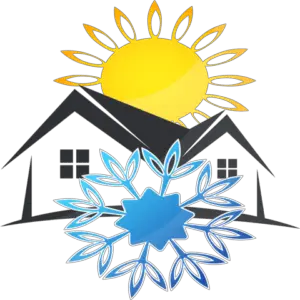This list comprises the main components of a heat pump, followed by a brief description of how they function. Read on for a more in-depth explanation of each.
- Compressor – Compresses the refrigerant (Freon) in the system.
- Compressor Contactor – Turns on the compressor and fan.
- Fan Motor – Pulls air through the refrigeration coil.
- Run Capacitors – Gives motor windings maximum efficiency.
- Start capacitor (optional) – Provides an initial start to the compressor.
- Defrost Control – Controls the timing of the defrost cycle.
- Reversing Valve – Changes unit between heating and cooling.
- Refrigeration Coil – To remove or pick up heat.
As an Amazon Associate, I earn commission from qualifying purchases.
What Part Does A Compressor Play In Heat Pump Operation?
Compressors for heat pumps and air conditioners operate on the same principle as an air compressor. The significant difference is that these compressors pump refrigerant instead of air, and the system is sealed. Compressors have a high-pressure outlet and a low-pressure inlet.
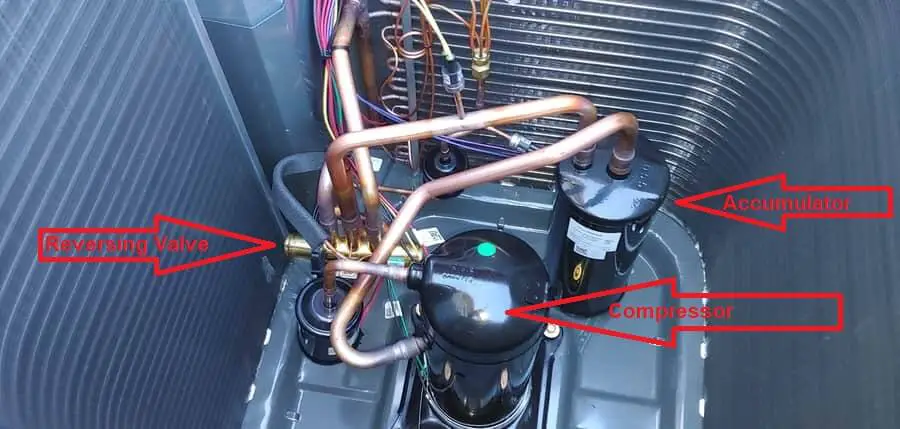
The low-pressure inlet is the larger of the two copper tubes attached to the housing. Copeland and Tecumseh are the two major manufacturers of compressors for residential HVAC.
Compressor failures have dramatically improved since the development of the scroll compressor. Early heat pumps had reciprocating compressors, which had pistons like car engines.
Slugging is a common problem with heat pumps. Compressors are designed to pump vapor. Liquid refrigerant entering the suction line (low-pressure inlet) can have devastating effects on a compressor.
The Accumulator
Most heat pumps have another component called an accumulator. If you follow the compressor suction line away from the compressor, you may see this tank. It’s slightly smaller than the compressor and is meant to hold any inrush of liquid before it reaches the compressor.
Most heat pumps have another component called an accumulator. If you follow the compressor suction line away from the compressor, you may see this tank. It’s slightly smaller than the compressor and is meant to hold any inrush of liquid before it reaches the compressor.
The Compressor Contactor
Compressor contactors serve a dual purpose. They start the compressor and the fan motor on a call from the thermostat for heating or cooling. These contactors are a common problem in heat pump failures. Constant arcing of the contacts eventually burns the finish off the open and close contacts.
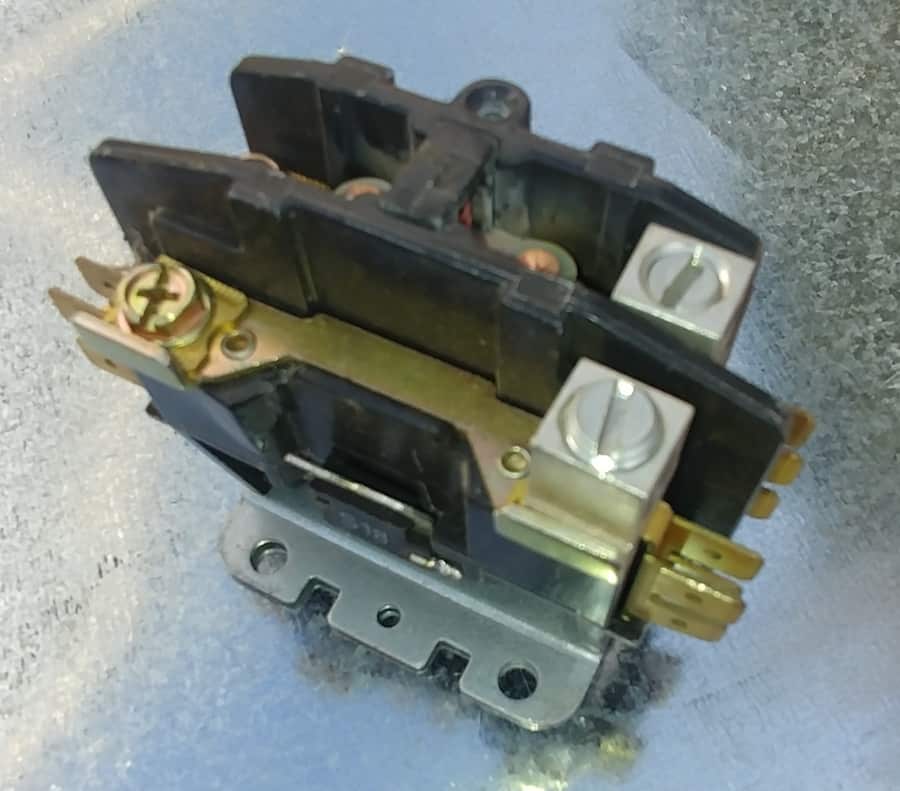
I’ve had service calls where spiders and frogs tried to make a home between the contacts and stopped the unit from starting.
If you want to replace a compressor contactor, I suggest one that looks slightly different from the one pictured above. The contacts will be covered. The Amazon link below shows how the contacts are protected.
| Heavy Duty 2 Poles Contactor 40 Amp 120 Volts Coil Replacement | Amazon |
Take some precautions if trying to select a contactor. A heat pump is powered with 240 Volts AC. Some contactors only switch one leg of the two that feed the unit. Order like for like unless you understand how to adapt one for the other.
To keep my truck inventory low, I keep only the contactors that break both lines and jumper across one set of contacts to keep the unit as wired.
How Important Is The Outdoor Fan And Motor?
Fan motors turn the fan to remove heat from the coil in summer and to pull heat through the coil in winter. The theory is that some heat is in the air, even in very low outdoor temperatures.
In the heat mode, the motor and fan pull this frigid air through the refrigeration coil to pick up heat, which is then transferred to the refrigerant inside the coil tubing. The process of compressing and metering takes place.
During the hot summer months, when the heat pump operates in cooling mode, the outdoor fan should run when the thermostat calls for cooling along with the compressor.
In the winter, the compressor should run as long as there is a demand for heating. However, the fan may cycle off occasionally when the defrost board determines there is ice or frost on the coil.
When the defrost cycle begins, the fan quits, the reversing valve reverses the refrigerant flow, and your heat pump goes into cooling mode.
In the cooling mode, the outdoor coil becomes the hot coil and melts the ice.
As you read on, some of this may seem repetitive, but it’s almost necessary to encompass the whole idea of a heat pump.
What Does A Motor Capacitor Do?
Engineers apply capacitors to various brands of heat pumps in several ways. We could get technical here, but let’s just say capacitors help motors start and become more efficient.
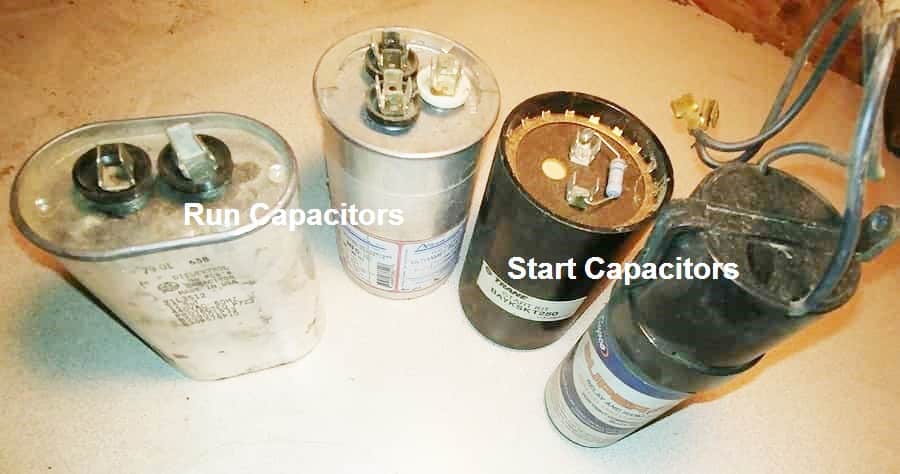
Capacitors give motors and compressors an initial boost to get going. Motors tend to draw a lot of current on startup. Not all heat pumps come with start capacitors, but they are considered an option.
If you see a start capacitor on your HVAC unit, a technician may have added it because your compressor had a hard time starting, or he was a good salesman and explained the benefits of having one.
The starting amps for a compressor with a start capacitor are about half those without a start cap. There is a part called a potential start relay. It allows the capacitor to be offline within a short moment after startup.
Can you save money by having a hard start kit? It’s probably not enough to celebrate anything, but you will reduce the stress of your compressor and have a smoother-running machine.
So, run capacitors stay online, and start capacitors are online only for seconds upon startup.
You can purchase either the simple two-wire boost or a complete kit (recommended). Check it out below with the link to Amazon. Be sure to order kits matching your unit’s tonnage or horsepower.
| Supco SPP8E E Series Electronic Potential Relay style Hard Start Kit | Amazon |
| Compressor Saver Hard Start Capacitor work on units 1-2-3 tons Hard Start Kit | Amazon |
What’s The Purpose Of The Defrost Control Board?
I can’t tell you how many service calls I’ve received from customers who say the outdoor fan quit. When I got to the customer’s house, the fan motor was running just as it should.
Then, I have to explain defrost cycles. Defrost cycles occur in winter. The two wires you see are sensors that monitor the outdoor temperature and coil temperatures. Some circuit boards only measure coil temperature.
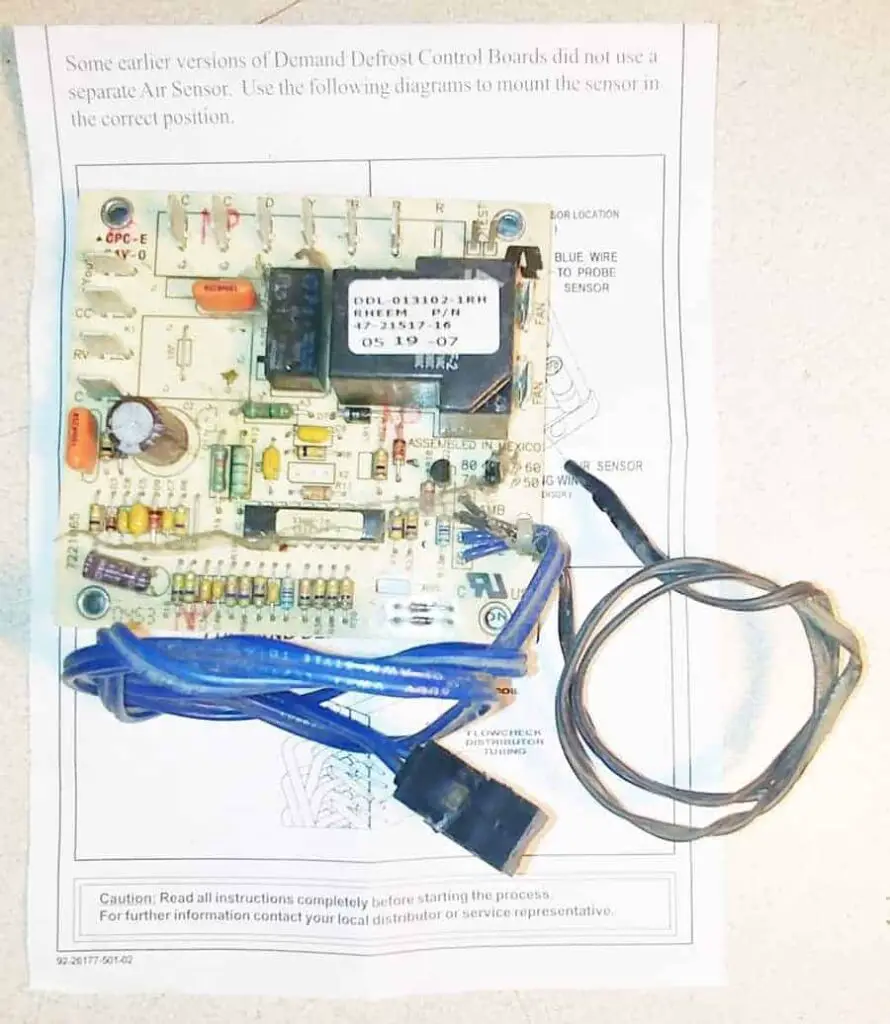
The circuit board has an adjustable timer. In my climate in Central Oregon, we set the timer for the unit to go into defrost every 30 minutes.
If the climate is cold enough to close the sensor, it will initiate a defrost cycle. The outdoor fan motor will stop, and the reversing valve will reverse. With the reversing valve switched to reverse, the heat pump will change into the cooling mode.
The outdoor coil will then become the hot coil, and the ice or frost will melt. When the system defrosts, it’s essential to have the bottom of the heat pump pan clear of debris so the water can drain.
If you look closely down through the fan, you should see holes or ports in the bottom of the unit. These holes allow for drainage, which is difficult if your heat pump is flat on the pad.
Heat pumps should be pumped up or raised above anticipated snow levels. If snow is not a factor in your region, keeping your unit up at least a few inches helps to keep it drained.
Allowing snow and ice to accumulate around the bottom of a heat pump in freezing weather can damage the bottom of the coils over time.
What’s The Function Of A Reversing Valve?
Reversing valves are a very precision-built part of a heat pump system. The copper line coming in at the bottom is always the high pressure from the compressor.
The middle line is always the return to the compressor. A slide inside the central part of the valve moves back and forth to divert the refrigerant flow from the inside coil to the outside coil.

The three very small copper lines you can see aid the slide in moving due to the pressure in the system. Along with an electric solenoid, the valve initiates movement whenever the thermostat calls for heat or cool or when the defrost board says, “Defrost the coil.”
Reversing valves can lock up or seize. Because of the close tolerances of the slide inside the valve, any foreign object in the system can lock it up. It’s important to consider replacing the system in older heat pumps before paying for either a compressor or a reversing valve replacement.
Refrigeration Coils And What They Do
Made out of aluminum fins and copper tubing, refrigeration coils are pretty fragile. Kids with bikes and hail storms bend the fins and close the gaps, reducing the efficiency.
The more fins that are bent and the more cottonwood tree stuff gets sucked into the coils, the less air moves through the coil to transfer heat.
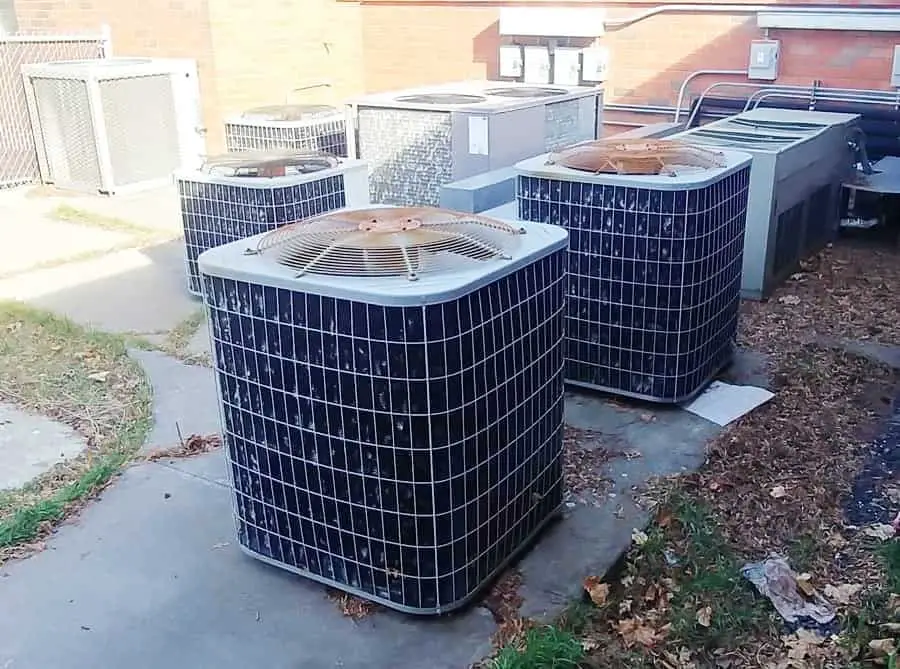
The tricky coils are the ones that look clean but are doubled up, and you cannot see between the layers without removing the top.
Conclusion
Heat pumps are a great way to heat and cool a home. However, their ratings range from good to bad.
Remember this: over 90% of bad ratings result from poor installations or lack of good maintenance, not lousy equipment.
From incorrect sizing to bad installation practices, it is all determined by finding the best contractor.
I hope this was helpful. If you have questions, you can contact me.
